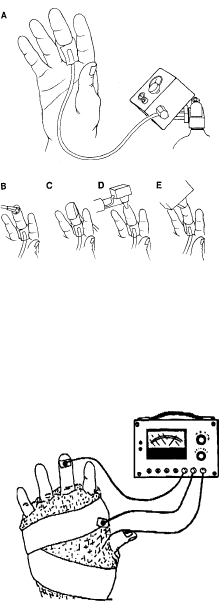
Digital Perfusion Assessment
Levinsohn et al (1991)
1
demonstrated that the infrared method of as-
sessing perfusion was as reliable as Doppler methods, but far less
expensive, much faster, and easier to use.
A: Venous congestion was induced
by placing a 28 mm wide cuff
on the proximal phalanx of the
long finger and then inflating the
cuff to 5 mm Hg above resting
diastolic pressure. With the aid
of a nitrogen pressure regula-
tor, cuff pressure was main-
tained for 60 minutes and as-
sessment of digital perfusion
was performed at 10 minute in-
tervals using:
B: Laser Doppler Flowmetry
C: Pulse Oximetry
D: Skin Surface Fluorescence
E: Skin Surface Temperature Mea-
surement via a DermaTemp
(Levinsohn et al 1991).
Reconstructive Surgery
Despite satisfactory technical replanta-
tion, patients may develop vascular per-
fusion problems postoperatively, which
lead to marginally perfused tissue or to
failure. Because any significant
change in perfusion is reflected as a
change in body surface temperature,
temperature measurement is an effec-
tive method of monitoring the ongoing
viability of replants and flaps
1
.
A study by Stirrat et al (1978)
2
on the
effect of temperature monitoring in digi-
tal replantation demonstrated a decline
in perfusion may be recognized earlier via temperature monitoring and
improvement gained by clinical measures before the need for reoperation
occurs. The objective temperature measurements allow a nurse or
nurses aide to follow condition, especially where skin color cannot be
followed easily, e.g. dark-skinned patients or with severely trauma
Evalutaion of methods of
detecting perfusion impairment
Stirrat et al (1978) study on the
effect of temperature on digital
replantation
22


















